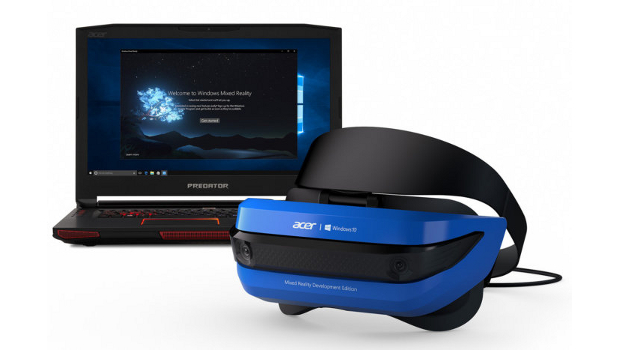Microsoft’s hardware partners will flood the market with Windows Mixed Reality headsets by end of this year, offering up a new way to enjoy Windows 10.
A Windows Mixed Reality headset from Acer is already being seeded to select developers by Microsoft, but isn’t available to consumers yet.
So far three PC makers – Lenovo and HP as well as Acer – said they would ship headsets later this year. Dell is still mulling a release date. The headsets will start at $299, the rough minimum price suggested by Microsoft.
The headsets need to be wired to Windows 10 PCs. Once on, they will transport you to a virtual world where you can, for example, roam, Skype-chat and play Xbox games. It’s like computing in a 3D world, without the use of a mouse or keyboard.
Acer will ship its Windows Mixed Reality headset to consumers for $299 in the fourth quarter, said Gregg Prendergrast, president of Acer Pan America.
The Acer Mixed Reality headset has a liquid crystal display with a 1440×1440 pixel resolution per eye. The display’s refresh rate is 90Hz. It also has audio out and microphone support and inside-out tracking. HDMI 2.0 and USB 3.0 connectors are bundled in one cable, needed to hook the headset up to PCs.
On its part, HP will also ship its version of the headset in the fourth quarter, said Ron Coughlin, president for personal systems at the company. He could not provide price guidance, but the company is making a major VR push later this year. It’s already working to connect Oculus Rift and HTC Vive headsets to its PCs.
Lenovo has already shown off its Windows Mixed Reality headset, coming later this year, a company spokeswoman said. That points to late third or fourth quarter.
Meanwhile, a Dell spokesman said the company doesn’t want to share its schedule publicly.
“We can confirm we’re developing a headset, like many other OEMs, based on the Microsoft spec. Right now we’re busy hammering away at the overall experience to ensure the device aligns to Dell expectations,” the spokesman wrote in an e-mail.
3Glasses and Asus are also developing Windows Mixed Reality headsets, though shipment dates for their products weren’t immediately available. 3Glasses is a lead partner for Microsoft, and its headset could be shown off at a Microsoft hardware event to be held later this month in Beijing.
The Windows headsets won’t work with just any PC. At a minimum, the PC will need Intel’s Core i5 Kaby Lake chip, and it will later support Intel’s integrated graphics.
Good PC performance is important for a smooth experience, said Greg Sullivan, a Microsoft spokesman.
A discrete GPU will provide a better experience. That’s a minimum requirement for the Oculus Rift and HTC Vive headsets, which don’t work on integrated graphics.
The headsets will support PCs based on the x86 instruction set, Sullivan said. He couldn’t provide specifics on support for AMD’s Ryzen chips. Microsoft has previously said that headsets will support AMD’s next-generation chips, which are Ryzen.
Microsoft’s specifications for the headsets do not include Windows 10 2-in-1s and laptops based on ARM-based Snapdragon chips from Qualcomm, which are expected later this year. However, Qualcomm has said that all Windows 10 applications will work with ARM PCs, so in theory, headsets could work when plugged into the ARM PCs.
IDG News Service








Subscribers 0
Fans 0
Followers 0
Followers